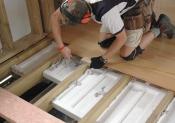Search
Login
Recommended
The blind area in a private house, types of blind areas, how to properly blind area in a private house, we make the blind area of \u200b\u200bthe house in stages
The construction of the house is completed, but the owners still have a lot of trouble, primarily aimed at ensuring the safety of their new home. Building constructions, no matter how strong they may seem at first glance, without proper protection can significantly suffer from the effects of frost, snow and rain, winds. This influence on the foundation is especially dangerous, because its deformation or partial destruction can adversely affect the strength of the entire structure of the house. As a protective measure around the house, it is recommended to build a blind area - it is it that is designed to protect the foundation from the damaging effects of rainfall.
Content
- What is the blind area of \u200b\u200ba private house
- Types of blind areas video
- How to make a blind area at home with your own hands video
- Blind from paving stones and paving slabs video
What is the blind area of \u200b\u200ba private house

The blind area of \u200b\u200ba private house is a strip of dense material, for example, concrete or asphalt, which adjoins the foundation, protecting it from moisture. When laying the blind area, the slope angle recommended by building codes is mandatory, which allows free flow of melt or rain water, usually it ranges from 10 to 15 degrees.
The recommended width of the blind area of \u200b\u200ba private house is from 0.8 to 1.2 - 1.5 m, it is located around the entire perimeter of the structure. It is difficult to overestimate the importance of the blind area for houses with a basement or basement: it not only significantly increases the strength of the foundation, but also contributes to the creation of an additional insulation layer that creates a thermal pillow.

In addition to the protective functions of the blind area around the house, it contributes to giving the building a more aesthetic and complete look. Practical owners resort to the construction of a blind area not only around the apartment building, but also around all kinds of technical and office premises, brick fences built on the estate.
Types of blind areas

In construction, it is customary to subdivide blind areas into three types:
- made of asphalt or stones
- classic
- monolithic.
Classical blind area usually has a width of 80 cm, is built around the entire perimeter of the structure, its slope is about 10 degrees. However, the width of the blind area should be selected taking into account the protrusion of the roof of the house, at least 20 cm should be added to it. The width may also depend on the type of soil in the area where the house is located: the lighter the soil is compressed, the wider the blind should be made. If there is a basement in the house, it is recommended to warm the blind area using heat-insulating material.

It should be noted that the blind area, no matter what material it is made of, will be subjected to destructive effects if the drainage from the roof is not made correctly or is absent.
Clay can be used as the basis of the classical blind area. The order of the work is as follows: a shallow (about 10 cm) trench is dug around the perimeter of the house, moist clay is poured into it and compacted tightly. After drying, the clay forms a dense mass that can provide the proper level of protection against moisture.
The borders of the blind area - borders, they should be dug into the ground up to half the height.
On top of the clay layer, crushed stone of the middle fraction is poured and compacted tightly. As the last layer, concrete or cement mortar, reinforced or monolithic, is used, often a composition of asphalt and artificial filler is used. The use of asphalt concrete, popular in urban housing, in a private house may not be practical: laying it requires the use of professional equipment and compliance with operating standards. In addition, asphalt concrete must be laid at a material temperature of the order of +120 degrees and an air temperature of at least +5 degrees.

For styling stone blind area will have to stock up on enough cobblestones and stones. In this case, the trench should have a depth of about 30 cm. Gravel is laid at the bottom of the trench, rammed, then clay is poured and compacted. To provide protection from moisture, a layer of insulating material, roofing material, is laid below and above the clay layer. Then they proceed to the construction of a decorative layer: selected stones are laid on a cement mortar.

The experts consider the best quality option monolithic type blind area. A monolithic blind area at home can be done if the owners are familiar with the technology for performing such work. In addition, it will require serious cash costs. In order to fill the trench only clean sand is used, it is compacted and poured with a layer of concrete with a thickness of 6 to 8 cm. The concrete must be of good quality and be resistant to freezing. The design must be strengthened with the help of reinforcement laid on the foundation before pouring concrete.

Also, one should not forget about the need to create a temperature joint in a monolithic structure. For this purpose, a board carefully selected and processed with resin and special means is used. Preference should be given to boards with a thickness of more than 15 mm. The temperature seam will prevent cracking of the monolithic coating, increase its resistance to mechanical stress with sharp changes.
How to make a blind area at home with your own hands
And now we will consider in detail how to make a blind area of \u200b\u200ba house with the help of hand-made reinforced plates. Making them is not very difficult. To create the slabs, it will be necessary to make a formwork measuring 60x60 cm. It is recommended to do it immediately on two slabs located next to each other. The height of the slab is 3 cm. The formwork boots are assembled in such a way that after solidification of the sand-cement mortar they were easy to disassemble.

To improve the quality characteristics of the plate it is recommended to reinforce, for a plate 3 cm thick it is very important to give additional rigidity. Any mesh with a mesh size greater than 8x8 cm can be used as a reinforcing component. Too large cells will lead to a decrease in the strength and stiffness of the finished product. You can use any metal products as a reinforcing component, for example, a cable or wire, but they must be cleaned of insulation.
After the manufacture of formwork, you can begin to manufacture slabs. The base of the formwork will need to be covered with polyethylene. The film should be carefully leveled. Next, the formwork is 2/3 in height poured with a solution prepared from 3 parts of sand and 1 part of cement, the prepared reinforcing mesh is laid, the rest of the solution is added until the desired height is obtained.
To improve the setting process, the surface of the tiles is covered with burlap. Formwork can be removed after 3-4 days. Plates made in this way can be used even if the drain is not properly organized. Plates laid on a prepared base will last a long period; moreover, they can be extended periodically by turning the plate 90 degrees.
In addition, self-made plates will help to ennoble the area around the house and give it a more decorative look: if desired, dyes of different colors can be added to the solution - the plates will be colored.
Blind from paving stones and paving slabs

Today, the construction market is saturated with all kinds of paving slabs and paving stones, their price is quite affordable, so often instead of hand-made production of plates for the blind area, resorting to the purchase of finished finishes. Industrial-made boards have their advantages:
- they fit very easily
- if necessary, damaged fragments are easily replaced with new ones,
- such tiles are resistant to high loads, moisture and low temperatures.
The device blinds at home is quite possible to do it yourself. For the blind area to serve for a long time, it will be necessary to properly prepare its base. Around the house, a trench is dug with a depth of about 40-50 cm, a drainage layer is laid in it: gravel, crushed stone, coarse sand with a thickness of 25 to 35 cm. The recommended slope of the blind area from paving slabs is from 5 to 10%, it is performed at the stage of the drainage system . The minimum slope is 1.5%, i.e. about 8 mm for every about 5 m blind area.
A gap of a couple of centimeters should be left between the foundation and the blind area, otherwise at negative temperatures the tile, expanding, will additionally create pressure on the foundation, which is extremely undesirable. The gap can be filled with sand, or polystyrene, closed with several layers of roofing material.

After the drainage layer, a layer of reinforced concrete is built, the dry mixture is poured, it is leveled and compacted, tiles are laid on it. An attractive factor in the use of paving slabs can be considered the diversity of its shape, size, wide color gamut.

When choosing the best option for the blind area around the house, it is necessary to take into account not only the financial side of the issue and the external attractiveness of the finishing material, so that the blind area lasts for a long time, first of all, it will be necessary to take into account the peculiarities of the soil structure on the site, its geographical location, the quality of the gutter system of the roof of the house.





